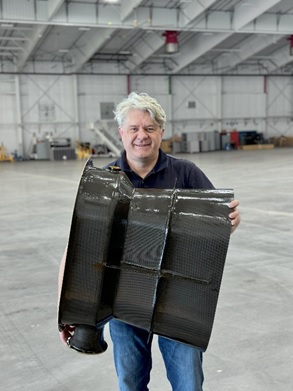EDMONDS, Wash., Sept. 24, 2024 (GLOBE NEWSWIRE) -- The bladeless thrusters were demonstrated in a static test at Moses Lake, Washington. This represents a major milestone reached in the completion of the prototype of the J-500 cargo drone propulsion system. The J-500 is being developed in collaboration with EANAN-Al-Samma. The tests were conducted at AeroTEC, who was subcontracted to perform the design of the pneumatic system and test of the thrusters using locally available compressed air conditioned to the exact pressure, flows and temperatures of the turbocompressor used in the J-500. The turbocompressor has passed Critical Design Review and is currently in the manufacturing phase.

Figure 1 Jetoptera's CTO, Dr. Andrei Evulet holding a 250 lbf class carbon fiber thruster that weighs less than 10 lb
The thrusters tested were the fore and aft thrusters and their respective valves. For the J-500 the rear thrusters are swiveling propulsors that are employed for VTOL and forward flight, whereas the front thrusters are fixed and only employed in vertical flight and transition phases.
The front thrusters are sized for producing up to 75 lbf whereas the rear thrusters are sized to produce up to 250 lbf.
Jetoptera’s Thrust Augmentation Ejectors (Thrusters) are far simpler, lighter and better performing than previous solutions attempted over the past decades. The thrusters are manufactured using additive manufacturing and carbon composite technologies, resulting in very light structures that are capable of augmented thrust compared to the turbofan/turbocompressor that produces the compressed air. In a typical installation, diverter valves distribute the compressed air across the airframe via a system of conduits, directing the flows with a very rapid reaction time to the thrusters, resulting in very smooth transitions to and from vertical flight. The thrusters entrain massive amounts of ambient air and produce a mixed flow of lower velocity but much higher mass, much like a bypass fan except without moving parts. This “equivalent bypass ratio” is quantitively like or exceeds those of the largest turbofans used in commercial wide bodies, typically between 7 and 15. The thrusters are designed to ensure an efficient momentum transfer inside them so that the mixed flow is of low velocity and temperature. The technology can be designed for various applications, V/STOL or conventional.
With this milestone reached, Jetoptera can build systems that produce 250 lbf per thruster, the size needed for the J-500 rear thrusters. The milestone is also important for the development of the J-2000 manned prototype, the rear J-500 thrusters being of identical design and sized for the front thrusters of the larger aircraft. “Jetoptera is reducing technology risk with a well-planned, gradual scale up of the FPS technology from the smallest thrusters (deployed in the FPS powered parafoil systems developed for Freedom Flight Works and DARPA programs) to the larger and larger sizes for the J Series fixed wing platforms. Our approach is to gradually, analytically, computationally and experimentally validate and scale up our technology to thousands of pounds of thrust. The right approach is to develop tools - including CFD, CAM, probabilistic models and unique experimental data - as well as the manufacturing methods – that make this scalability possible in the most disciplined manner,” says Dr. Andrei Evulet, CEO of Jetoptera.
The test was performed at the Flight test facility of AeroTEC in Moses Lake, Washington.
For information about this press release please contact Todd Newton todd@jetoptera.com
Jetoptera, Inc. https://www.jetoptera.com
Facebook: https://www.facebook.com/Jetoptera/
LinkedIn: https://www.linkedin.com/company/jetoptera/posts/?feedView=all
A photo accompanying this announcement is available at https://www.globenewswire.com/NewsRoom/AttachmentNg/dfe83afb-6ceb-4a23-8986-e3c67c0422d7
